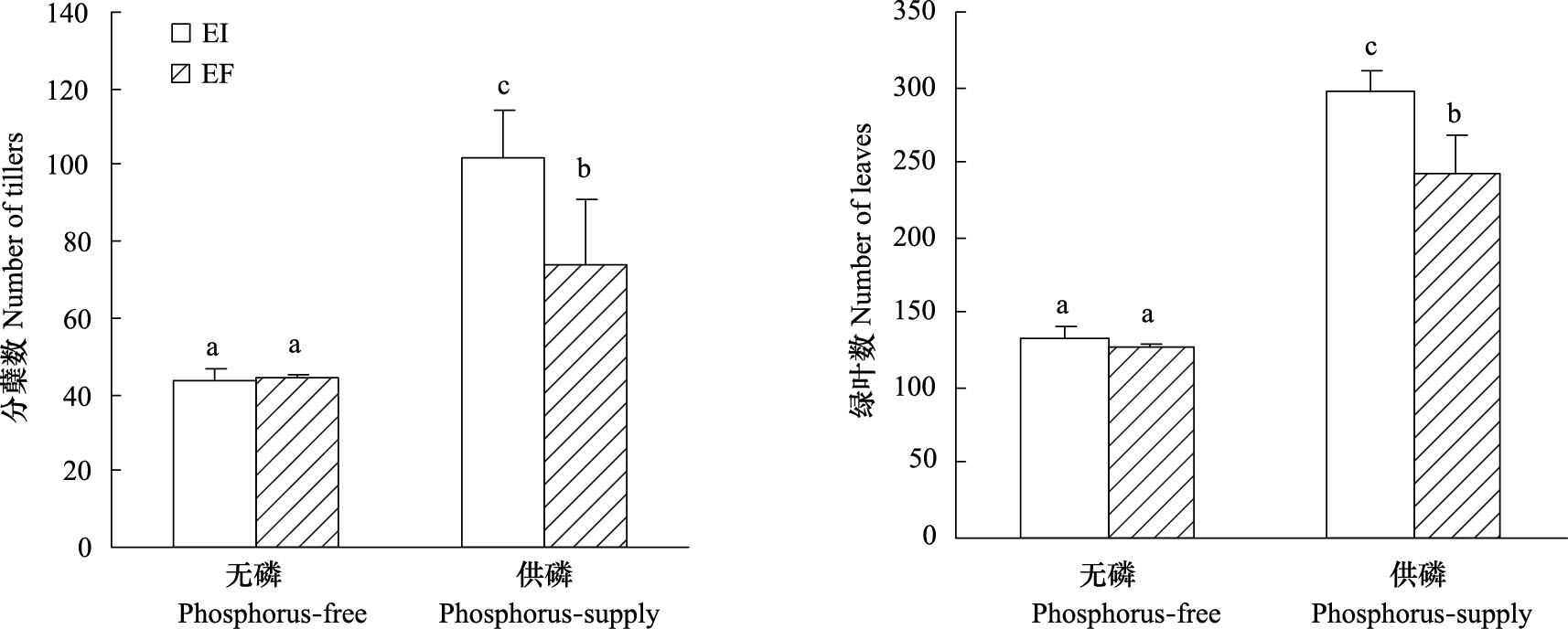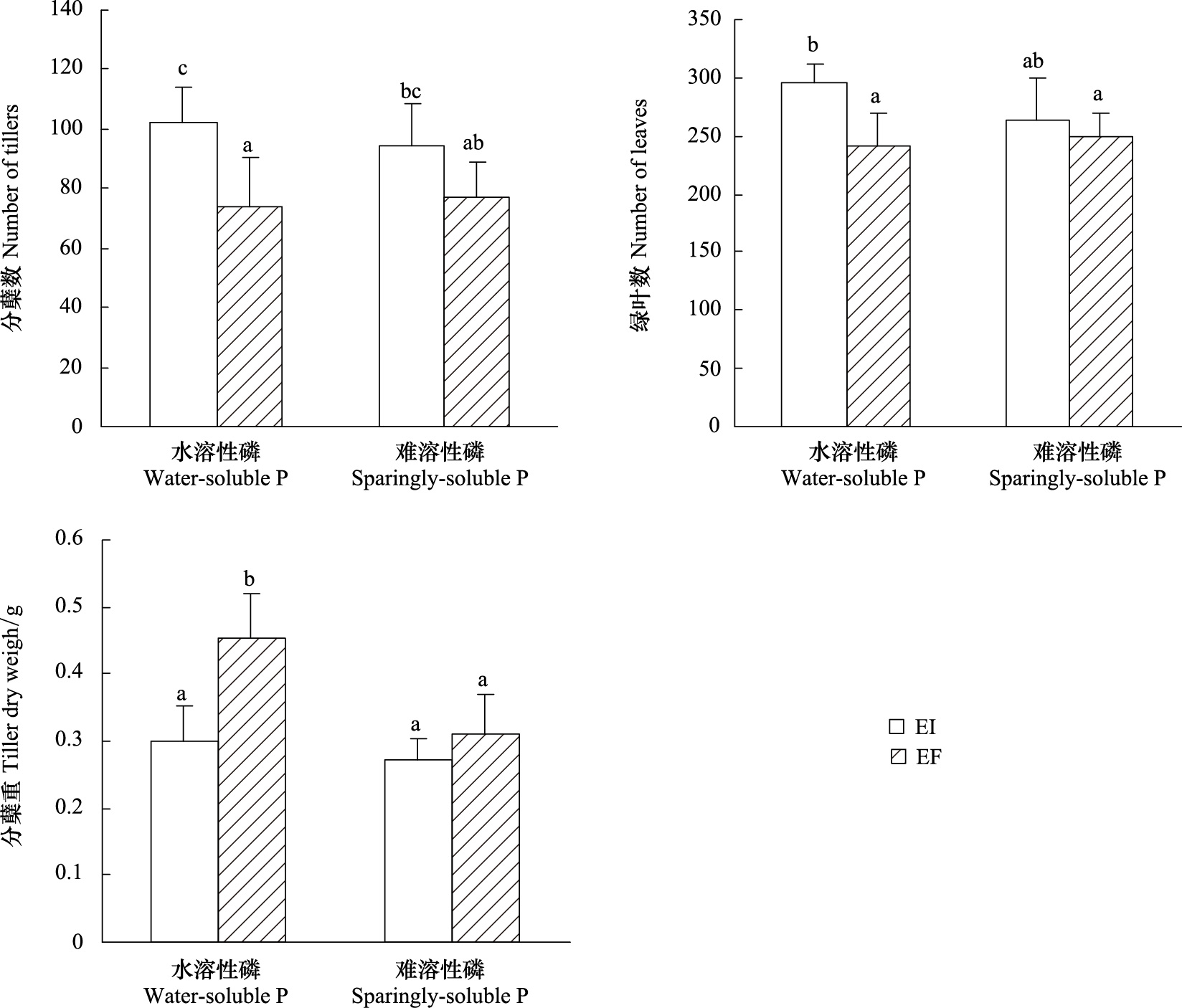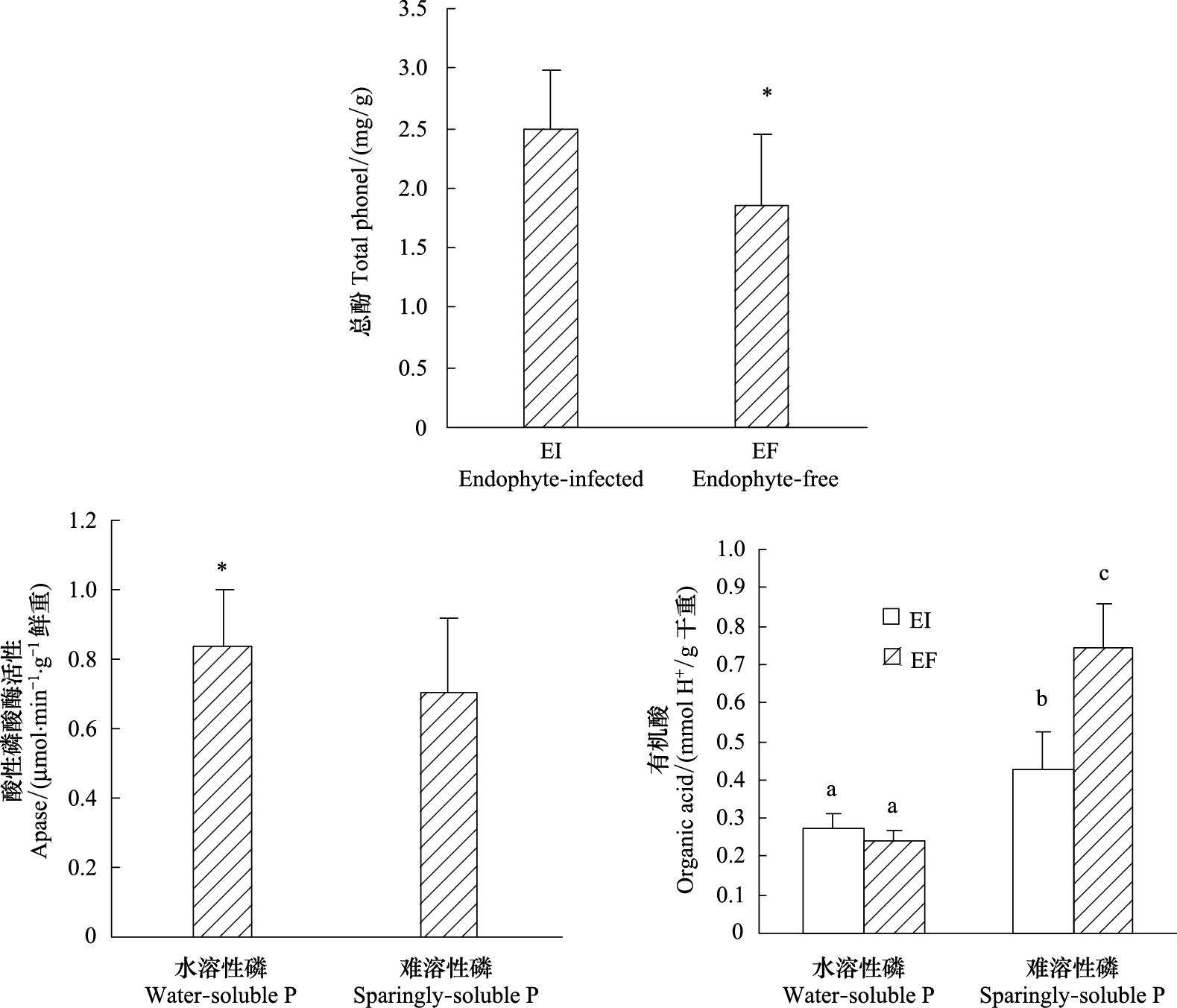文章信息
- 荆元芳, 吴连杰, 马传洋, 任安芝, 高玉葆
- JING Yuanfang, WU Lianjie, MA Chuanyang, REN Anzhi, GAO Yubao
- 不同浓度和形态磷处理下内生真菌感染对高羊茅的影响
- Effects of endophyte infection on tall fescue in different phosphorus levels and forms
- 生态学报, 2014, 34(13): 3576-3583
- Acta Ecologica Sinica, 2014, 34(13): 3576-3583
- http://dx.doi.org/10.5846/stxb201211061548
-
文章历史
- 收稿日期:2012-11-6
- 修订日期:2014-2-25
The experiment was carried out in the greenhouse on the campus of Nankai University. There were three phosphate fertilizer treatments, i.e. application of sparingly soluble phosphorus fertilizer, water-soluble phosphorus fertilizer and no addition of phosphorus fertilizer. Each treatment consisted of 5 pots of EI and 5 pots of EF tall fescue plants. In addition, N, P, and K fertilizer were applied with 300, 100, and 150mg/kg, respectively. At the end of the experiment, we noted the number of tillers and leaves, and measured the dry weight of the shoot and the root. Besides, we detected the content of total phenol and organic acid as well as the activity of acid phosphatase (Apase).
When no P fertilizer was added, there was no significant difference in growth between EI and EF plants, and EI plants tended to perform worse than EF plants. When normal P fertilizer was supplied, EI plants had more tillers and leaves than EF plants, which may partly prove the viewpoint that the beneficial effect of endophyte infections usually occurs in high soil nutrients conditions.
As for the responses to different phosphorus forms, we found that the root organic acid content and the acid phosphatase activity were significantly higher in the sparingly-soluble P conditions than in the water-soluble P conditions, while total phenol content of the root was similar between the two treatments. In the water-soluble P conditions, EI plants had both higher content of total phenol and more tillers, and leaves than EF plants, which indicated that the endophyte had certain contributions to shoot growth of the host plants. In the sparingly-soluble P conditions, EI roots had higher content of total phenol but lower content of organic acids than EF plants; meanwhile, endophyte infection just increased the root-shoot ratio of the host plants. This indicated that endophyte infection contributed little to the host plants in using sparingly-soluble P. Since we did not determine the root morphology of the experimental tall fescue, we could not rule out the possibility of endophyte infection changing the root morphology of tall fescue without changing the root biomass, which needs further study. Besides, whether endophyte infection is beneficial to the host plant in the P-deficient condition depends on the host plant species or varieties. In a word, our experiment indicated that endophyte infection was more beneficial to host growth when water-soluble P was supplied.
磷是植物生长发育所必需的营养元素之一。但是我国土壤全磷含量很低,有效磷含量更少,仅约占全磷的1%,施入土壤中的磷肥一般得不到有效利用,其利用效率只有10%—25%,其余均转化为植物难以吸收利用的难溶性磷,为此邹茗[1]提出,提高磷肥有效性有两条途径,一是减少水溶性磷肥的固定,二是促进难溶性磷肥的溶解。
据报道,菌根对宿主植物利用难溶性磷肥具有促进作用[2]。丛枝菌根能帮助植物有效利用土壤中难溶态磷如Ca-P、A1-P,或者矿化有机磷[3],从而促进宿主植物对难溶态磷的吸收和利用。菌根改善植物磷素营养的机理包括以下几个方面:一是通过菌丝扩大植物根系的吸收面积;二是改善根际微环境(包括分泌质子和有机酸以降低土壤pH值,以及分泌磷酸酶,改变土壤难溶态磷的形态和化学有效性,或刺激土壤微生物分泌有机酸,促进植物对难溶性磷的活化利用);三是促进磷元素在植物体内运输[4]。
与菌根真菌类似,内生真菌(Endophytic fungi)也是与植物共生的一类真菌,只不过内生真菌通常存在于植物地上部分。Azevedo[5]认为内生真菌很可能是植物体中的磷库,内生真菌的菌丝也可积累无机磷,这一点和菌根真菌相似。另外,周芳等[6]和Ren等[7]在黑麦草的研究中也发现,在缺磷条件下,内生真菌感染有助于宿主植物的生长,那么,内生真菌感染对宿主植物的这一有益影响是否具有普遍性?如果有,其原因是否也是因为内生真菌感染导致宿主根系的吸收能力改变?或者是与内生真菌感染改变了宿主根际环境有关呢?目前的相关研究很少[8]。本文选取高羊茅为材料,探讨了沙培条件下内生真菌感染对宿主植物利用不同浓度和形态磷肥的影响,从而为更加合理的利用禾草-内生真菌共生体提供理论依据。
1 材料与方法 1.1 实验材料本实验材料采用高羊茅(Festuca arundinacea Schreb.),品种名为 Kentucky-31,与内生真菌N.coenophialum 构成共生关系。其种子由Keith Clay教授赠送,留存于南开大学网室(本次实验所用的高羊茅于2011年9月在南开大学网室中采集)。
1.2 实验方法采用两因素随机区组实验设计,因素之一为内生真菌感染情况,分为EI和EF两个个水平;因素之二为磷肥,分为难溶性磷肥(Ca3 (PO4) 2)、水溶性磷肥(Ca(H2PO4) 2-H2O)和不施磷肥,每个处理5个重复。
播种前,用蒸馏水冲洗待用的沙子数次直至电导率接近于0。采用(直径23 cm,高25 cm)白色塑料盆,每盆称重装入洗过的细沙5 kg。分别将两种磷肥粉末与每盆沙子充分混和,施磷量为50 mg/kg,即每盆施磷250 mg,同时保证氮肥(150 mg/kg) 和钾肥(75 mg/kg)供给充足,即每盆施375 mg,即6.321 g Ca(NO3)2和0.716 g KCl。
本实验于南开大学温室中进行,2011年12月13日于每盆沙土中播种50 粒内生真菌感染和非感染的高羊茅种子,待发芽后定株到43 株。实验中期追肥1次,与初始用量相同,即本实验施肥总量为N 300 mg/kg,P 100 mg/kg,K 150 mg/kg。
1.3 指标的测定 1.3.1 生长指标2012年4月4日测定植株分蘖数和绿叶数;将地上和地下分开收获,用自来水冲洗干净,于烘箱中70 ℃烘24 h后称地上干重、地下干重,并计算总干重、根冠比和分蘖重。
1.3.2 生理指标酸性磷酸酶(APase)活性测定参考Mclanchlan[9] 的方法;总酚含量测定参照Malinowski等[10]的方法;有机酸总量测定参考肖志红等[11]。
1.4 数据的统计分析采用 IBM SPSS Statistics 19统计分析软件和Excel 2010绘图。
2 实验结果 2.1 不同浓度磷处理下内生真菌感染对高羊茅的影响 2.1.1 分蘖数和绿叶数内生真菌感染和磷浓度对高羊茅分蘖数和绿叶数均有显著影响,具体表现在缺磷条件下,高羊茅EI(染菌)和EF(不染菌)植株分蘖数和绿叶数均无显著差异(P>0.05);正常供磷条件下,高羊茅EI植株分蘖数和绿叶数显著高于EF植株(P<0.05)。无论内生真菌感染与否,缺磷导致高羊茅植株分蘖数和绿叶数显著减少(P<0.01,表 1,图 1)。
|
变量
Variable | 内生真菌(E)
Endophyte | 磷浓度(PL)
Phosphorus level | 内生真菌×磷浓度
E×PL | |||
| F | Sig | F | Sig | F | Sig | |
| *,**分别表示P<0.05,0.01,NS表示差异不显著 | ||||||
| 分蘖数Number of tillers | 8.667 | ** | 89.81 | ** | 9.181 | ** |
| 绿叶数Number of leaves | 17.57 | ** | 374.5 | ** | 11.46 | ** |
| 地下干重Root dry weight | 2.313 | NS | 39.33 | ** | 0.538 | NS |
| 地上干重Above-ground dry weight | 0.178 | NS | 257.2 | ** | 0.154 | NS |
| 总干重Total dry weight | 0.910 | NS | 176.6 | ** | 0.341 | NS |
| 根冠比Root-shoot ratio | 3.028 | NS | 52.81 | ** | 0.021 | NS |

|
| 图 1 不同磷浓度条件下内生真菌感染对高羊茅分蘖数和绿叶数的影响 Fig. 1 Effects of endophyte on the number of tillers and leaves of tall fescue in different phosphorus levels EI,EF分别表示感染内生真菌和不感染内生真菌 |
无论内生真菌感染与否,缺磷导致高羊茅生物量显著下降,根冠比显著增加(P<0.01,表 1);无论是缺磷还是正常供磷,内生真菌对高羊茅生物量均无显著影响(P>0.05,表 2)。
|
处理
Treatment | 地下干重/g
Root dry weight | 地上干重/g
Above-ground dry weight | 总干重/g
Total dry weight | 根冠比
Root-shoot ratio | |
| 同一列数字无相同字母则差异达5%的显著水平 | |||||
| 无磷 | EI | 4.906±1.022a | 8.681±1.111a | 13.59±2.038a | 0.563±0.068b |
| Phosphorus-free | EF | 5.363±0.957a | 8.706±1.178a | 14.07±2.075a | 0.614±0.057b |
| 供磷 | EI | 8.123±0.842b | 22.040±2.957b | 30.16±3.672b | 0.370±0.027a |
| Phosphorus-supply | EF | 9.433±1.851b | 22.730±1.699b | 32.17±3.322b | 0.413±0.076a |
内生真菌对高羊茅分蘖数、分蘖重及绿叶数均有显著影响(P<0.01,表 3)。在水溶性磷条件下,高羊茅EI植株分蘖数和绿叶数显著多于EF植株,分蘖重显著低于EF植株;在难溶性磷处理下,EI植株分蘖数和绿叶数虽有高于EF植株的趋势,但差异不显著(P>0.05,图 2)。
|
变量
Variable | 内生真菌(E)
Endophyte | 磷形态(PF)
Phosphorus form | 内生真菌×磷形态
E×PF | |||
| F | Sig | F | Sig | F | Sig | |
| *,**分别表示P<0.05,P<0.01,NS表示差异不显著 | ||||||
| 分蘖数Number of tillers | 12.92 | ** | 0.174 | NS | 0.751 | NS |
| 分蘖重Average tiller dry weight | 8.896 | ** | 6.730 | * | 3.110 | NS |
| 绿叶数Number of leaves | 9.113 | ** | 1.119 | NS | 2.871 | NS |
| 地下干重Root dry weight | 0.086 | NS | 0.136 | NS | 5.829 | * |
| 地上干重Above-ground dry weight | 0.165 | NS | 52.791 | ** | 0.135 | NS |
| 总干重Total dry weight | 0.019 | NS | 26.257 | ** | 1.907 | NS |
| 根冠比Root-shoot ratio | 1.258 | NS | 25.097 | ** | 6.615 | * |
| 总酚Total phenol | 6.335 | * | 0.023 | NS | 0.037 | NS |
| 有机酸Organic acid | 16.19 | ** | 86.81 | ** | 24.84 | ** |
| APase活性Acid phosphatase activity | 0.968 | NS | 15.334 | ** | 0.053 | NS |

|
| 图 2 不同形态磷条件下内生真菌感染对高羊茅分蘖数、绿叶数和分蘖重的影响 Fig.2 Effects of endophyte on the number of tillers,leaves and average tiller dry weight of tall fescue in different P forms EI,EF分别表示感染内生真菌和不感染内生真菌 |
在水溶性磷条件下,虽然高羊茅EI植株拥有更多分蘖数,由于其分蘖重显著小于EF植株,因此在水溶性磷条件下,内生真菌对高羊茅生物量无显著影响(P>0.05,表 4);在难溶性磷条件下,高羊茅EF植株根冠比变化不大,而EI植株根冠比显著增加,从而使得EI植株根冠比显著高于EF植株(P<0.01)。不考虑内生真菌感染情况,难溶性磷导致高羊茅地上部干重和总干重低于水溶性磷,而根冠比高于水溶性磷。
|
处理
Treatment | 地下干重/g
Root dry weight | 地上干重/g
Above-ground dry weight | 总干重/g
Total dry weight | 根冠比
Root-shoot ratio | |
| 同一列数字无相同字母则差异达5%的显著水平 | |||||
| 水溶性磷 | EI | 8.123±0.842a | 22.037±2.957b | 30.160±3.672b | 0.370±0.027a |
| Water-soluble P | EF | 9.433±1.958a | 22.733±1.699b | 32.166±3.322b | 0.413±0.070ab |
| 难溶性磷 | EI | 9.386±1.025a | 15.838±1.140a | 25.224±1.298a | 0.596±0.085c |
| Sparingly-soluble | PEF | 7.715±1.424a | 15.872±1.796a | 23.587±2.930a | 0.486±0.069b |
内生真菌感染对高羊茅根总酚和有机酸含量均有显著影响。对于总酚,EI植株根总酚含量显著高于EF植株(P<0.05,图 3),而磷形态对根总酚含量无显著影响(P>0.05,表 3)。对于有机酸,在水溶性磷条件下,高羊茅EI与EF植株根有机酸含量无显著差异;在难溶性磷条件下,高羊茅EI植株根有机酸含量显著低于EF植株(P<0.05,图 3)。对于APase活性,在不同形态磷肥处理中,高羊茅EI植株根APase活性均有高于EF植株的趋势,但未达到显著水平(P>0.05,图 3)。磷形态对APase活性具有显著影响,无论内生真菌感染与否,水溶性磷条件下高羊茅根中APase活性显著低于难溶性磷(P<0.01)。

|
| 图 3 不同形态磷条件下内生真菌感染对高羊茅根部总酚含量、有机酸含量和酸性磷酸酶活性的影响 Fig.3 Effects of endophyte on total phenol,organic acid content and acid phosphatase activity of tall fescue in different P forms EI,EF分别表示感染内生真菌和不感染内生真菌 |
很多研究表明,内生真菌对高羊茅的营养生长有一定促进作用。例如,Clay[12]和De Battista[13]等人研究发现经过14周生长,高羊茅EI植株分蘖数和生物量均显著高于EF植株。然而,越来越多的研究发现,内生真菌感染对宿主植物生长的影响依赖于土壤养分含量,在低养分下内生真菌对宿主的有利性很小或为负,随养分含量增加有利性增大。例如,对高羊茅[14]和草地羊茅[15]的研究发现,与EF植株相比, EI植株在高养分条件下生长更好,而在低养分条件下生长较差,推测是因为内生真菌与宿主竞争消耗养分或光合产物。Cheplick等[16]对黑麦草的研究发现,内生真菌导致宿主植物生长付出一定代价,这种代价在贫瘠环境中更明显。而且,内生真菌的影响与宿主基因型及内生真菌种类有关。任安芝等[17]对羽茅的研究也发现,内生真菌对羽茅的有益贡献在充足水分高养分条件下最大,而在低养分条件下有所减小;在养分胁迫条件下,EF植株分配更多的养分用于光合,而EI植株则更侧重于防御。
其中,关于内生真菌感染对宿主氮素利用方面影响的研究较多。Belesky等[18]和Newman等[19]研究发现,与低氮相比,在高氮水平下高羊茅EI植株生长显著优于EF植株。而关于磷素的研究比较少,以黑麦草[6, 7]和羽茅[20]为材料的研究发现,在磷缺磷胁迫下,内生真菌对宿主植物生长更有利。相反,本实验发现,缺磷条件下,高羊茅EI和EF植株生长(绿叶数、分蘖数和生物量)差异不显著,EI植株甚至比EF植株表现略差一些;而正常供磷条件下,高羊茅EI植株生长显著优于EF植株。这进一步证明了随着土壤养分含量增加,内生真菌对宿主植物的有利性增大的观点。
3.2 不同形态磷处理下内生真菌感染对宿主植物生长及生理的影响不同形态磷处理下内生真菌感染对高羊茅的影响体现在生长和生理两个方面。
在生长方面,Belesky等[21]对高羊茅的研究发现,在水溶性磷(KH2PO4)供给下,与EF植株相比,EI植株地上和地下生物量分别增加11%和13%,但根冠比无显著变化。之后,Malinowski等[8]对同一基因型高羊茅供给难溶性磷(磷矿粉)发现,EI植株地下生物量增加10%,地上生物量和根冠比无显著变化。本实验也发现,在水溶性磷处理下,高羊茅EI植株比EF植株拥有更多分蘖数和绿叶数,对生物量无显著影响;而在难溶性磷处理下,内生真菌感染只是增加了宿主植物根冠比,对分蘖数和绿叶数等无显著(P>0.05)影响。由此可见,内生真菌对宿主高羊茅生长在水溶性磷条件下更有利。
在生理方面,关于磷形态对植物影响的研究主要集中在总酚、有机酸和APase活性等方面。首先,酚类物质是重要的植物次生代谢物之一,该类物质含量的增加不仅有助于植物对食草动物的阻食和对逆境的适应[22],而且这些化合物通过结合可溶性Al、Fe和 Mn,将PO3-4从难溶性磷中释放出来,增加土壤中可溶性磷含量,以提高植物对磷的吸收。据报道,感染内生真菌的禾草比不感染植株含有更多酚类化合物[6, 9, 23]。本研究发现,高羊茅EI植株根总酚含量显著高于EF植株(P<0.05),而磷形态对根总酚含量无显著影响(P>0.05)。这说明内生真菌感染确能使宿主高羊茅体内总酚含量增加,进而促进宿主植物磷利用效率。染菌禾草和不染菌禾草在酚类含量上的差异,说明酚类是禾草、|内生真菌维持共生关系的长期策略之一,且可能与防御有关[24]。其次,有机酸在溶解、活化土壤中难溶性磷酸盐方面发挥重要作用,这些小分子量有机酸与Fe、A1、Ca等离子有较强的螯合能力,通过与难溶性磷中的磷酸根离子进行阴离子交换或竞争吸附反应,将磷从Fe-P、A1-P和Ca-P及其他固定态磷中释放或者置换出来,提高植物对磷的吸收利用能力[25, 26]。此外,APase活性增加也是植物对缺磷的一种适应性反应[27]。据报道,与不接种菌根和接种菌根且施水溶性磷肥的土壤相比,接种丛枝菌根且施难溶性磷矿粉的土壤APase活性显著增加;菌根感染率增高使枳苗根系分泌APase活性增强,进而使植株磷含量增加[28]。任安芝[7]等也发现在缺磷条件下,内生真菌感染导致黑麦草叶片APase活性显著增加。本实验发现,在难溶性磷条件下高羊茅根有机酸和APase活性显著增加(P<0.05),但EI植株根有机酸含量显著低于EF植株(P<0.05);无论水溶性磷或难溶性磷处理,内生真菌对APase活性均无显著影响。说明有机酸和APase对活化和吸收难溶性磷确实有一定作用,但内生真菌对促进难溶性磷活化作用不大。
总之,在缺磷条件下内生真菌对宿主植物是否有利与宿主植物的种或品种有关,本研究中内生真菌感染对高羊茅的有益影响出现在正常供水溶性磷条件下,此时,内生真菌感染显著提高了宿主根总酚含量,但对根系生物量、有机酸和APase活性无显著影响;而在难溶性磷条件下,虽然高羊茅EI植株根总酚含量仍然高于EF植株,但同时EI植株根有机酸含量显著低于EF植株,因此内生真菌感染对宿主利用难溶性磷贡献不大,当然,因未对根系形态进行测定,因此不能排除内生真菌感染在没有导致根生物量变化的同时却改变了宿主根系的形态,而这一点还有待于进一步研究。
| [1] | Zou M. Influence of form changing of the phosphorus fertilizer in the soil on phosphate fertilizer effectiveness. Sichuan Agriculture Technology, 2005, (6): 36-36. |
| [2] | Liu J F, Xia R X, Wang M Y, Wang P. Recent advances in phosphorus acquisition from non-labile sources in plants with arbuscular mycorrhizal interaction. Subtropical Plant Science, 2007, 36(4): 62-66. |
| [3] | Smith S E, Smith F A, Jakobsen I. Mycorrhizal fungi can dominate phosphate supply to plants irrespective of growth responses. Plant Physiology, 2003, 133(1): 16-20. |
| [4] | Yi S L, Wen M X, Li X P, Shi X J. Progresses in improvement of plant P nutrition by VA mycorrhizal fungi. Chinese Agricultural Science Bulletin, 2004, 20(5): 164-166. |
| [5] | Azevedo M D, Welty R E. A study of the fungal endophyte Acremonium coenophialum in the roots of tall fescue seedlings. Mycologia, 1995, 87(3): 289-297. |
| [6] | Zhou F, Gao Y B, Ma W J. Effects of phosphorus deficiency on growth of perennial ryegrass-fungal endophyte symbiont and phenolic content in root. Plant Physiology Communications, 2003, 39(4): 321-324. |
| [7] | Ren A Z, Gao Y B, Zhou F. Response of Neotyphodium lolii-infected perennial ryegrass to phosphorus deficiency. Plant, Soil and Environment, 2007, 53(3): 113-119. |
| [8] | Malinowski D P, Brauer D K and Belesky D P. The endophyte Neotyphodium coenophialum affects root morphology of tall fescue grown under phosphorus defciency. Agronomy and Crop Science, 1999, 183(1): 53-60. |
| [9] | Mclanchlan K D. Acid phosphatase activity of intact roots and phosphorus nutrition in plants (I): Assay conditions and phosphatase activity. Australian Journal of Agricultural Research, 1980, 31(3): 429-440. |
| [10] | Malinowski D P, Alloush G A, Belesky D P. Evidence for chemical changes on the root surface of tall fescue in response to infection with the fungal endophyte Neotyphodium coenophialum. Plant and Soil, 1998, 205(1): 1-12. |
| [11] | Xiao Z H, Liu H Y, Liu Y X, Wang F, Zhang Y J. Detection of organic acid content of different hawthorn varieties. Journal of Henan Agricultural Science, 2006, (5): 88-89. |
| [12] | Clay K. Effects of fungal endophytes on the seed and seedling biology of Lolium perenne and Festuca arundinacea. Oecologia, l987, 73(3): 358-362. |
| [13] | De Battista J P, Bacon C W, Severson R, Plattner R D, Bouton J H. Indole acetic acid production by the fungal endophyte of tall fescue. Agronomy Journal, l990, 82(5): 878-880. |
| [14] | Cheplick G P, Clay K, Marks S. Interactions between infection by endophytic fungi and nutrient limitation in the grasses Lolium perenne and Festuca arundinacea. New Phytologist, 1989, 111(1): 89-97. |
| [15] | Wali P R, Helander M, Nissinen O, Lehtonen P, Saikkonen K. Endophyte infection, nutrient status of the soil and duration of snow cover influence the performance of meadow fescue in subartic conditions. Grass and Forage Science, 2008, 63(3): 324-330. |
| [16] | Cheplick G P. Costs of fungal endophyte infection in Lolium perenne genotypes from Eurasia and North Africa under extreme resource limitation. Environmental and Experimental Botany, 2007, 60(2): 202-210. |
| [17] | Ren A Z, Li X, Han R, Yin L J, Wei M Y, Gao Y B. Benefits of a symbiotic association with endophytic fungi are subject to water and nutrient availability in Achnatherum sibiricum. Plant and Soil, 2011, 346(1/2): 363-373. |
| [18] | Belesky D P, Devine O J, Pallas J E Jr, Stringer W C. Photosynthetic activity of tall fescue as influenced by a fungal endophyte. Photosynthetica, 1987, 21: 82-87. |
| [19] | Newman J A, Abner M L, Dado R G, Gibson D J, Brookings A, Parsons A J. Effects of elevated CO2, nitrogen and fungal endophyte-infection on tall fescue: growth, photosynthesis, chemical composition and digestibility. Global Change Biology, 2003, 9(3): 425-437. |
| [20] | Li X, Ren A Z, Han R, Yin L J, Wei M Y, Gao Y B. Endophyte-mediated effects on the growth and physiology of Achnatherum sibiricum are conditional on both N and P availability. PLoS ONE, 2012, 7(11): e48010. |
| [21] | Belesky D P, Fedders J P. Tall fescue development in response to Acremonium coenophialum and soil acidity. Crop Science, 1995, 35(2): 529-533. |
| [22] | Lin K M, Ye F M, Lin Y, Li Q S. Research advances of phenolic functional mechanisms in soils and plants. Chinese Journal of Eco-Agriculture, 2010, 18(5): 1130-1137. |
| [23] | Malinowski M, Belesky D P, Lewis G C. Abiotic stresses in endophytic grasses//Robert C, West C P, Spiers D E, eds. Neotyphodium in Cool Season Grasses. Blackwell, Iowa, 2005: 187-199. |
| [24] | Monica S T, James F W, Zhang X, Dorothy M H, Charles W B. Endophyte-mediated adjustments in host morphology and physiology and effects on host fitness traits in grasses. Fungal Ecology, 2012, 5(3): 322-330. |
| [25] | Li Y Y, Zeng Z J, Li X F, Wang Y X, Huang Q C. Mobilization of sparingly soluble phosphate by Secale cereale L. and its corresponded mechanisms. Acta Botanica Boreali-Occidentalia Sinica, 2008, 28(4): 724-729. |
| [26] | Lan Z M, Lin X J, Zhang W G, Zhang H, Wu Y Q. Effect of P deficiency on the emergence of Astragalus L. root exudates and mobilization of sparingly soluble phosphorus. Scientia Agricultura Sinica, 2012, 45(8): 1521-1531. |
| [27] | Zhou J Z, Han X R, Xi H G. Effects of phosphorus rate on root phosphatase activities of different sugar beet genotypes. Plant Nutrition and Fertilizer Science, 2006, 12(2): 233-239. |
| [28] | Tang Z Y, He S L. Research of the mechanism of mycorrhizal promoting the cirtrus to uptake of insoluble phosphate. Chinese Orange, 1991, 20(2): 7-10. |
| [1] | 邹茗. 土壤中磷肥化学形态变化对磷肥有效性的影响. 四川农业科技, 2005, (6): 36-36. |
| [2] | 刘进法, 夏仁学, 王明元, 王鹏. 丛枝菌根促进植物根系吸收难溶态磷的研究进展(综述). 亚热带植物科学, 2007, 36(4): 62-66. |
| [4] | 易时来, 温明霞, 李学平, 石孝均. VA菌根改善植物磷素营养的研究进展. 中国农学通报, 2004, 20(5): 164-173. |
| [6] | 周芳, 高玉葆, 马文江. 缺磷对黑麦草-内生真菌共生体生长和根中酚含量的影响. 植物生理学通讯, 2003, 39(4): 321-324. |
| [11] | 肖志红, 刘红彦, 刘玉霞, 王飞, 张玉军. 不同山楂品种有机酸含量的检测. 河南农业科学, 2006, (5): 88-89. |
| [26] | 兰忠明, 林新坚, 张伟光, 张辉, 吴一群. 缺磷对紫云英根系分泌物产生及难溶性磷活化的影响. 中国农业科学, 2012, 45(8): 1521-1531. |
| [22] | 林开敏, 叶发茂, 林艳, 李卿叁. 酚类物质对土壤和植物的作用机制研究进展. 中国生态农业学报, 2010, 18(5): 1130-1137. |
| [25] | 李耀燕, 曾志军, 黎晓峰, 玉永雄, 黄秋婵. 黑麦对难溶性磷酸盐的吸收及活化机制研究. 西北植物学报, 2008, 28(4): 724-729. |
| [27] | 周建朝, 韩晓日, 奚红光. 磷营养水平对不同基因型甜菜根磷酸酶活性的效应. 植物营养与肥料学报, 2006, 12(2): 233-239. |
| [28] | 唐振尧, 何首林. 菌根促进柑桔吸收难溶性磷肥的机理研究. 中国柑桔, 1991, 20(2): 7-10. |
 2014, Vol. 34
2014, Vol. 34




